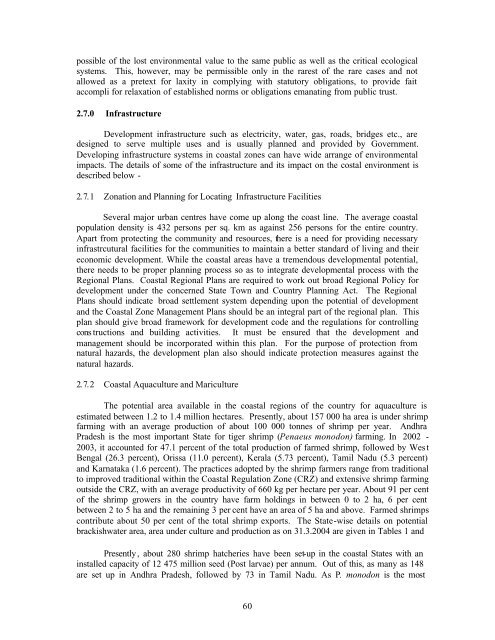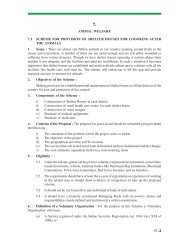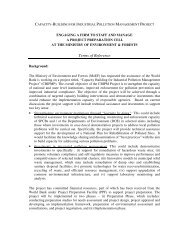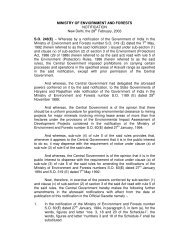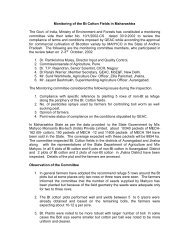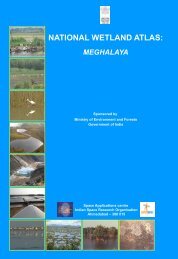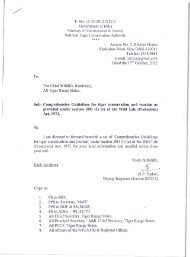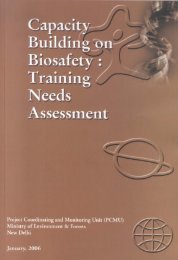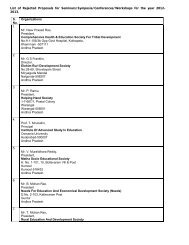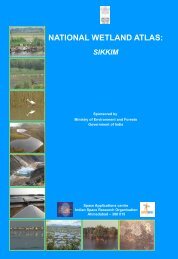pdf - Ministry of Environment and Forests
pdf - Ministry of Environment and Forests
pdf - Ministry of Environment and Forests
- TAGS
- ministry
- forests
- moef.nic.in
You also want an ePaper? Increase the reach of your titles
YUMPU automatically turns print PDFs into web optimized ePapers that Google loves.
possible <strong>of</strong> the lost environmental value to the same public as well as the critical ecological<br />
systems. This, however, may be permissible only in the rarest <strong>of</strong> the rare cases <strong>and</strong> not<br />
allowed as a pretext for laxity in complying with statutory obligations, to provide fait<br />
accompli for relaxation <strong>of</strong> established norms or obligations emanating from public trust.<br />
2.7.0 Infrastructure<br />
Development infrastructure such as electricity, water, gas, roads, bridges etc., are<br />
designed to serve multiple uses <strong>and</strong> is usually planned <strong>and</strong> provided by Government.<br />
Developing infrastructure systems in coastal zones can have wide arrange <strong>of</strong> environmental<br />
impacts. The details <strong>of</strong> some <strong>of</strong> the infrastructure <strong>and</strong> its impact on the costal environment is<br />
described below -<br />
2.7.1 Zonation <strong>and</strong> Planning for Locating Infrastructure Facilities<br />
Several major urban centres have come up along the coast line. The average coastal<br />
population density is 432 persons per sq. km as against 256 persons for the entire country.<br />
Apart from protecting the community <strong>and</strong> resources, there is a need for providing necessary<br />
infrastrcutural facilities for the communities to maintain a better st<strong>and</strong>ard <strong>of</strong> living <strong>and</strong> their<br />
economic development. While the coastal areas have a tremendous developmental potential,<br />
there needs to be proper planning process so as to integrate developmental process with the<br />
Regional Plans. Coastal Regional Plans are required to work out broad Regional Policy for<br />
development under the concerned State Town <strong>and</strong> Country Planning Act. The Regional<br />
Plans should indicate broad settlement system depending upon the potential <strong>of</strong> development<br />
<strong>and</strong> the Coastal Zone Management Plans should be an integral part <strong>of</strong> the regional plan. This<br />
plan should give broad framework for development code <strong>and</strong> the regulations for controlling<br />
cons tructions <strong>and</strong> building activities. It must be ensured that the development <strong>and</strong><br />
management should be incorporated within this plan. For the purpose <strong>of</strong> protection from<br />
natural hazards, the development plan also should indicate protection measures against the<br />
natural hazards.<br />
2.7.2 Coastal Aquaculture <strong>and</strong> Mariculture<br />
The potential area available in the coastal regions <strong>of</strong> the country for aquaculture is<br />
estimated between 1.2 to 1.4 million hectares. Presently, about 157 000 ha area is under shrimp<br />
farming with an average production <strong>of</strong> about 100 000 tonnes <strong>of</strong> shrimp per year. Andhra<br />
Pradesh is the most important State for tiger shrimp (Penaeus monodon) farming. In 2002 -<br />
2003, it accounted for 47.1 percent <strong>of</strong> the total production <strong>of</strong> farmed shrimp, followed by Wes t<br />
Bengal (26.3 percent), Orissa (11.0 percent), Kerala (5.73 percent), Tamil Nadu (5.3 percent)<br />
<strong>and</strong> Karnataka (1.6 percent). The practices adopted by the shrimp farmers range from traditional<br />
to improved traditional within the Coastal Regulation Zone (CRZ) <strong>and</strong> extensive shrimp farming<br />
outside the CRZ, with an average productivity <strong>of</strong> 660 kg per hectare per year. About 91 per cent<br />
<strong>of</strong> the shrimp growers in the country have farm holdings in between 0 to 2 ha, 6 per cent<br />
between 2 to 5 ha <strong>and</strong> the remaining 3 per cent have an area <strong>of</strong> 5 ha <strong>and</strong> above. Farmed shrimps<br />
contribute about 50 per cent <strong>of</strong> the total shrimp exports. The State-wise details on potential<br />
brackishwater area, area under culture <strong>and</strong> production as on 31.3.2004 are given in Tables 1 <strong>and</strong><br />
Presently, about 280 shrimp hatcheries have been set-up in the coastal States with an<br />
installed capacity <strong>of</strong> 12 475 million seed (Post larvae) per annum. Out <strong>of</strong> this, as many as 148<br />
are set up in Andhra Pradesh, followed by 73 in Tamil Nadu. As P. monodon is the most<br />
60


